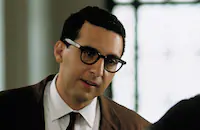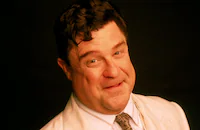O Brother, Where Art Thou?

Brief Synopsis
Cast & Crew
Joel Coen
George Clooney
Tim Blake Nelson
John Turturro
Holly Hunter
John Goodman
Film Details
Technical Specs
Synopsis
Ulysses Everett McGill is having difficulty adjusting to his hard-labor sentence in Mississippi. He scams his way off the chain gang with simple Delmar and maladjusted Pete, then the trio sets out to pursue freedom and the promise of a fortune in buried treasure. With nothing to lose and still in shackles, their hasty run takes them on an incredible journey of awesome experiences and colorful characters.
Director

Joel Coen
Cast

George Clooney
Tim Blake Nelson

John Turturro

Holly Hunter

John Goodman

Charles Durning
Michael Badalucco
Christy Taylor
Sharon White
Suzanne Cox
Willard Cox
Lindsey Miller
Isaac Freeman
Sidney Cox
Frank Collison
April Hardcastle
Michael W Finnell
Stephen Root
Musetta Vander
Ed Snodderly
Robert Hamlett
Georgia Rae Rainer
David Holt
Marianna Breland
Buck White
Sheryl White
Mia Tate
Natalie Shedd
John Mcconnell
Daniel Von Bargen
Wilson Waters
Del Pentecost
Lee Weaver
Wayne Duvall
John Locke
Mark Weissenfluh
Gillian Welch
Milford Fortenberry
Ray Mckinnon
Evelyn Cox
John Hartford
Quinn Gasaway
Brian Reddy
A Ray Ratcliff
Chris Thomas King
J.r. Horne
Royce D Applegate
Ed Gale
Crew
Harley Allen
Dean Allison
J. Todd Anderson
Karyn Anonia
Paige Augustine
Randall Balsmeyer
Pedro Barquin
Michael Barry
Kirk Barton
Jill Berliner
Nancy Bernstein
Michael R. Berry
Tim Bevan
James David Biggs
Melody Bishop
Jean Black
Norman Blake
Josh Blakeslee
Deborah 'cha' Blevins
Robert Bodenheimer
Jill Bogdanowicz
Steve Bowerman
Clayton Bowman
Bill Bradford
Craig A Brink
Shawn J. Broes
Erik L Brown
James Brown
Albert E Brumley
Kathy Brunswick
Roy Bryson
Shane Buckallew
Carter Burwell
John Cameron
John Cameron
A P Carter
Maybelle Carter
Mrs. Sidney Carter
Kam Chan
Ben Cheah
Ellen Chenoweth
Peter Chesney
Kathleen Chopin
Jeff Christopherson
Celeste Cleveland
Ethan Coen
Ethan Coen
Ethan Coen
Joel Coen
Joel Coen
Amy Minda Cohen
Kyle Collinsworth
Mike Compton
Steve Constancio
Blaine Converse
Tricia Cooke
Linda S Cormany
Marko Costanzo
Gerri Lee Crews
Carrie Crossman
Erik Darling
Jimmie Davis
Sandy Dawes
Roger Deakins
Robert E Denn
Matt Di Franco
David Diamond
David Diliberto
David Diliberto
Michelle Dixon
Clint Dougherty
Juliette Dow
Danny Downey
Peter Dress
Brennan Dufresne
John Dugan
Jenny Eagan
Thom Ehle
Pat Enright
Pat Enright
Caroline Eselin
Jennifer Euston
Kevin Fahey
Alan Faucher
Christian Fauntleroy
Eric Fellner
Chris Fielder
Alan Frazier
Julius Friede
Neil Gahm
Reynaldo Garcia
Stan Garner
Sean Garnhart
Sean Garnhart
Dennis Gassner
Lauren Gaston
Eugene Gearty
Karen Ruth Getchell
Nich Giangiullu
Charley H Gilleran
Daniel J Gillooly
Adam Gilmore
Julie Goldberg
Melinda Sue Gordon
Robert Graf
Senor Greaser
Joe Grimaldi
Glen Gustafson
Nancy Haigh
Ted Haigh
Bruce Hamme
April Hardcastle
Andy Harris
Emmylou Harris
John Hartford
Jennifer Henderson
Jerry Henery
Don J Hewitt
Jery Hewitt
Derek Hurd
Karyn L. Huston
Nicholas Irwin
Kenton Jakub
Nancy James
Skip Nehemiah James
Sondra James
Jennifer Jason Leigh
Roderick Jaynes
Roderick Jaynes
Roderick Jaynes
Jeff Jensen
Richard L Johnson
Thomas R Johnston
Kim Jordan
Casey Kasemier
Kathy Kelehan
Frank Kern
Stephanie Kern
Ivan Kerum
Neda Kerum
Nina Khoshaba
Chris Thomas King
Glenn Klekowski
Jeremy Knaster
Alison Krauss
Ritchie Kremer
Peter Kurland
Hiro Lam
Jennifer Lamb
Bill Landrum
Jacqui Landrum
George Lara
Alan Larman
Larry Laurent
Paul Leblanc
Mark Leone
Daniel Leung
Daniel Leung
Julian Levi
Skip Lievsay
Skip Lievsay
Mitch Lillian
Colin Linden
Tinker Linville
Alan Lomax
Cookie Lopez
Robert E Loring
Debra Macculloch
April Mackin
Betsy Magruder
Anand Mahendra
Deborah Mannis-gardner
Charlie Marroquin
Brad Martin
Harry Mcclintock
Harry Mcclintock
Tom Mcdaniel
Frank Mceldowney
Niles Mcelroy
Michael A Mcfadden
Jonathan Mcgarry
James Meehan
Alissa N Miller
Gray Miller
Gray Miller
Hoyt Ming
Thomas Minton
Charles Mitchell
Theresa Repola Mohammed
Smriti Mundhra
Donald W Murphy
Erik Nash
Bill Neff
Tim Blake Nelson
Otto Nemenz
Ray Nevin
Alan O'bryant
Katherine O'carroll
Mark O'kane
Billy O'leary
Videos
Movie Clip





Film Details
Technical Specs
Award Nominations
Best Adapted Screenplay
Best Cinematography
Articles
O Brother, Where Art Thou? - O Brother, Where Art Thou?
It has a remarkable (if playfully skewed) fidelity to the epic poem of mythical struggle, even if the filmmaking brother act never actually read Homer's work (as they take pains to point out). "But we read the comic book version of The Odyssey," confessed Ethan, as well as saw Hollywood spectacles and Ray Harryhausen fantasies based on, inspired by or selectively cribbed from it. Yet Homer's epic poem is merely one of many inspirations for a film that Joel described as "the Lawrence of Arabia of hayseed comedies." You could call the opening scenes a Three Stooges version of I Was a Fugitive from a Chain Gang (1932). They pick up a blues guitarist (Chris Thomas King) on his way to the crossroads to seal his deal with the devil (a classic blues legend), tag along with Baby Face Nelson on a bank robbery spree ("My name is George Nelson! Not Baby Face!") and crash a Ku Klux Klan rally that looks like a marching band halftime show and plays out like a scene from The Wizard of Oz (1939). Colorful tidbits from real-life southern politics and good 'ol boy populism of the thirties and forties make up the crazy quilt backdrop of their adventure. Hillbilly humor and screwball scenes play out in surreal imagery. And the title comes from one of the great depression comedies of all time: Preston Sturges' Sullivan's Travels (1941). It's the name of the social drama that earnest, ambitious Hollywood comedy director John Sullivan so desperately wants to make that he hits the road as a hobo to learn the hardscrabble human condition first hand. In that film, Sullivan has a change of heart when he sees the joy that comedies bring even the most wretched souls. The lesson isn't lost on the Coens. Despite the heavy-hearted title, their depression road movie is lighthearted and whimsical and filled with infectious music.
O Brother, Where Art Thou? is populated with familiar faces from previous Coen films-Hunter, Goodman, Turturro, Charles Durning, Michael Badalucco-but it's their first collaboration with Clooney, who was their first choice for the lead. In Clooney, they found a star with the look of a thirties matinee idol and the snappy delivery of a seasoned Hollywood comic. The actor, who grew up in Kentucky, jumped on the project and embraced the role of the pomade-addicted convict, and he turned to his uncle for help in mastering the accent he'd lost long ago. "I sent him a tape recorder with a script and asked him to read all of my lines," he told an interviewer. "I just did my Uncle Jack through the whole thing."
The "old-timey" blues, folk, gospel and country that fills the soundtrack was not just an integral part of the film. It sparked a whole revival of American roots music, spawning a Grammy-winning album and a couple of concert tours featuring the soundtrack artists. T-Bone Burnett compiled the archival songs (which included actual chain gang chants recorded by Alan Lomax) and produced the original music performed by such artists as Alison Krauss, John Hartford, Emmylou Harris and Gillian Welch. Clooney rehearsed his own vocals for weeks but ended up lip synching the film's signature song "A Man of Constant Sorrow" to the vocals of Dan Tyminski. He can claim credit for his own stage moves, however, including a hokey chicken dance that he remembered from his Kentucky childhood. According to Clooney, the film's choreographers hated it but it made the Coens laugh.
Though Joel Coen has solo director credit and Ethan takes producer credit, they were essentially co-directors on the film. According to cast members, they were both on set, each focusing on different parts of the scene, often swapping places like a tag team, yet always in synch when it came to what they wanted out of a scene. They also edited the film together under the pseudonym Roderick Jaynes.
O Brother, Where Art Thou? received Academy Award nominations for Ethan and Joel Coen's screenplay (duly nominated in the "Based on Material Previously Produced or Published" category) and for Roger Deakins' golden hued cinematography. The film was shot on location across Mississippi during the winter, when the country was green and wet, and he turned to digital recoloring to achieve that sepia-tinged dustbowl look and faded yesteryear atmosphere. That level of delicate digital color manipulation wasn't unknown at the time (Spielberg had used it to give Saving Private Ryan its distinctive color palette in 1998) but still a fairly radical step for a film in 2000, especially one produced on a Coen Brothers budget. It all paid off. Their odyssey (or is it their Odyssey?), reworked as a tall tale in the folk song idiom of superstition, magic realism and religious mysticism and delivered with a mix of screwball goofiness and intellectual whimsy, spins a surreal story from imagination, inspiration and ingenuity. It hit a chord with the public and became their biggest hit to date and remains one of their most beloved films.
Producer: Ethan Coen; Joel Coen (uncredited)
Director: Joel Coen; Ethan Coen (uncredited)
Screenplay: Ethan Coen, Joel Coen; Homer (epic poem "The Odyssey")
Cinematography: Roger Deakins
Art Direction: Richard Johnson
Music: T Bone Burnett
Film Editing: Roderick Jaynes, Roderick Jaynes, Tricia Cooke
Cast: George Clooney (Everett), John Turturro (Pete), Tim Blake Nelson (Delmar), John Goodman (Big Dan Teague), Holly Hunter (Penny), Chris Thomas King (Tommy Johnson), Charles Durning (Pappy O'Daniel), Del Pentecost (Junior O'Daniel), Michael Badalucco (George Nelson), J.R. Horne (Pappy's Staff), Brian Reddy (Pappy's Staff), Wayne Duvall (Homer Stokes), Ed Gale (The Little Man), Ray McKinnon (Vernon T. Waldrip), Daniel Von Bargen (Sheriff Cooley), Royce D. Applegate (Man with Bullhorn), Frank Collison (Wash Hogwallop).
C-105m. Letterboxed. Closed Captioning.
by Sean Axmaker

O Brother, Where Art Thou? - O Brother, Where Art Thou?
Quotes
Trivia
Miscellaneous Notes
Nominated for the 2000 Award for Best Cinematography from the American Society of Cinematographers (ASC).
Nominated for the 2000 Eddie Award for Best Edited Feature - Comedy or Musical, from the American Cinema Editors (ACE).
Expanded Release in United States January 12, 2001
Released in United States August 2000
Released in United States October 2000
Released in United States on Video June 12, 2001
Released in United States Winter December 22, 2000
Shown at Edinburgh International Film Festival (Gala) August 13-27, 2000.
Began shooting June 7, 1999.
Completed shooting August 23, 1999.
Expanded Release in United States January 12, 2001
Released in United States on Video June 12, 2001
Released in United States August 2000 (Shown at Edinburgh International Film Festival (Gala) August 13-27, 2000.)
Released in United States October 2000 (Shown at AFI Fest 2000: The American Film Institute Los Angeles International Film Festival (Opening Night) October 19-26, 2000.)
Released in United States Winter December 22, 2000













